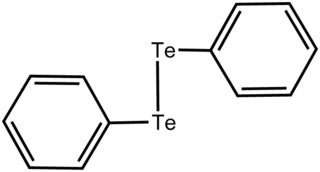Related Research Articles

In organic chemistry, an alkene is a hydrocarbon containing a carbon–carbon double bond. The double bond may be internal or in the terminal position. Terminal alkenes are also known as α-olefins.
Propylene, also known as propene, is an unsaturated organic compound with the chemical formula CH3CH=CH2. It has one double bond, and is the second simplest member of the alkene class of hydrocarbons. It is a colorless gas with a faint petroleum-like odor.
In chemistry, dehydrogenation is a chemical reaction that involves the removal of hydrogen, usually from an organic molecule. It is the reverse of hydrogenation. Dehydrogenation is important, both as a useful reaction and a serious problem. At its simplest, it's a useful way of converting alkanes, which are relatively inert and thus low-valued, to olefins, which are reactive and thus more valuable. Alkenes are precursors to aldehydes, alcohols, polymers, and aromatics. As a problematic reaction, the fouling and inactivation of many catalysts arises via coking, which is the dehydrogenative polymerization of organic substrates.
In organic chemistry, hydrocyanation is a process for conversion of alkenes to nitriles. The reaction involves the addition of hydrogen cyanide and requires a catalyst. This conversion is conducted on an industrial scale for the production of precursors to nylon.
Reductive amination is a form of amination that involves the conversion of a carbonyl group to an amine via an intermediate imine. The carbonyl group is most commonly a ketone or an aldehyde. It is a common method to make amines and is widely used in green chemistry since it can be done catalytically in one-pot under mild conditions. In biochemistry, dehydrogenase enzymes use reductive amination to produce the amino acid, glutamate. Additionally, there is ongoing research on alternative synthesis mechanisms with various metal catalysts which allow the reaction to be less energy taxing, and require milder reaction conditions. Investigation into biocatalysts, such as lRED, have allowed for higher selectivity in the reduction of chiral amines which is an important factor in pharmaceutical synthesis.
Deoxygenation is a chemical reaction involving the removal of oxygen atoms from a molecule. The term also refers to the removal of molecular oxygen (O2) from gases and solvents, a step in air-free technique and gas purifiers. As applied to organic compounds, deoxygenation is a component of fuels production as well a type of reaction employed in organic synthesis, e.g. of pharmaceuticals.

Diphenylditelluride is the chemical compound with the formula (C6H5Te)2, abbreviated Ph2Te2 This orange-coloured solid is the oxidized derivative of the unstable benzenetellurol, PhTeH. Ph2Te2 is used as a source of the PhTe unit in organic synthesis and as a catalyst for redox reactions.

γ-Valerolactone (GVL) or gamma-valerolactone is an organic compound with the formula C5H8O2. This colourless liquid is one of the more common lactones. GVL is chiral but is usually used as the racemate. It is readily obtained from cellulosic biomass and is a potential fuel and green solvent.

2,3-Butanediol is the organic compound with the formula (CH3CHOH)2. It is classified as a vic-diol (glycol). It exists as three stereoisomers, a chiral pair and the meso isomer. All are colorless liquids. Applications include precursors to various plastics and pesticides.
Amide reduction is a reaction in organic synthesis where an amide is reduced to either an amine or an aldehyde functional group.
Carbon dioxide reforming is a method of producing synthesis gas from the reaction of carbon dioxide with hydrocarbons such as methane with the aid of noble metal catalysts. Synthesis gas is conventionally produced via the steam reforming reaction or coal gasification. In recent years, increased concerns on the contribution of greenhouse gases to global warming have increased interest in the replacement of steam as reactant with carbon dioxide.
Organorhenium chemistry describes the compounds with Re−C bonds. Because rhenium is a rare element, relatively few applications exist, but the area has been a rich source of concepts and a few useful catalysts.
Water oxidation is one of the half reactions of water splitting:

Alfons Baiker is a Swiss Chemist specializing in Catalysis. Baiker studied chemistry at ETH Zurich. After obtaining his PhD in 1974 he followed several post-doctoral stays at various universities. In 1989 he became a full professor in catalysis and reaction engineering at ETH where he worked until his retirement in 2010.
The OxFA process is a process to produce formic acid from biomass by catalytic oxidation using molecular oxygen or air. Polyoxometalates of the Keggin-type are used as catalysts.

A smart cosubstrate is a type of cosubstrate used for cofactor regeneration to yield greater productivity and lower environmental impact (E-factor). A good example of a smart cosubstrate is a lactonizable diol.
Mahdi Muhammad Abu-Omar is a Palestinian-American chemist, currently the Duncan and Suzanne Mellichamp Professor of Green Chemistry in the Departments of Chemistry & Biochemistry and Chemical Engineering at University of California, Santa Barbara.
In organic chemistry, hydrovinylation is the formal insertion of an alkene into the C-H bond of ethylene. The more general reaction, hydroalkenylation, is the formal insertion of an alkene into the C-H bond of any terminal alkene. The reaction is catalyzed by metal complexes. A representative reaction is the conversion of styrene and ethylene to 3-phenybutene:
Olefin Conversion Technology, also called the Phillips Triolefin Process, is the industrial process that interconverts propylene with ethylene and 2-butenes. The process is also called the ethylene to propylene (ETP) process. In ETP, ethylene is dimerized to 1-butene, which is isomerized to 2-butenes. The 2-butenes are then subjected to metathesis with ethylene.

Selin Kara is a Turkish-born chemist and biotechnologist. She is currently a full professor and head of Industrial Biotechnology section at Aarhus University. She studies biocatalysis and has been recognized for her work about deep eutectic solvents and her research regarding cofactor regeneration in biotransformations.
References
- ↑ Boucher-Jacobs, Camille; Nicholas, Kenneth M. (2014). Deoxydehydration of polyols. Vol. 353. pp. 163–184. doi:10.1007/128_2014_537. ISBN 978-3-319-08653-8. ISSN 0340-1022. PMID 24756633.
{{cite book}}:|journal=ignored (help) - ↑ Liu, Shuo; Yi, Jing; Abu-Omar, Mahdi M. (2016). "Deoxydehydration (DODH) of Biomass-Derived Molecules". Reaction Pathways and Mechanisms in Thermocatalytic Biomass Conversion II. Green Chemistry and Sustainable Technology. Springer, Singapore. pp. 1–11. doi:10.1007/978-981-287-769-7_1. ISBN 9789812877680.
- 1 2 Kwok, Kelvin Mingyao; Choong, Catherine Kai Shin; Ong, Daniel Sze Wei; Ng, Joy Chun Qi; Gwie, Chuandayani Gunawan; Chen, Luwei; Borgna, Armando (2017-06-07). "Hydrogen-Free Gas-Phase Deoxydehydration of 2,3-Butanediol to Butene on Silica-Supported Vanadium Catalysts". ChemCatChem. 9 (13): 2443–2447. doi:10.1002/cctc.201700301. ISSN 1867-3880.
- ↑ Petersen, Allan R.; Nielsen, Lasse B.; Dethlefsen, Johannes R.; Fristrup, Peter (2018-01-08). "Vanadium-Catalyzed Deoxydehydration of Glycerol Without an External Reductant". ChemCatChem. 10 (4): 769–778. doi:10.1002/cctc.201701049. ISSN 1867-3880.